|
|
Post by Dave Homewood on Jun 26, 2011 14:43:30 GMT 12
A case of Maori Culture versus Air Force culture. Each equally important in its own right to its own people. |
|
|
|
Post by Tony on Jun 26, 2011 22:10:54 GMT 12
Dave
HQ:A is showing an overpaint of an RAF Serial.
The only one that ends in 05 that was allocated to us was ET605 that became NZ3013.
Here is a scan from Aircam #6 that shows P-40 '9' with the non-standard fuselage insignia.

Speaking of non-standard fuselage insignia here is another one.
Note the apparent colour of the spinners. The white aircraft codes are visible so are the spinners parinted in a dark coloue like grey?
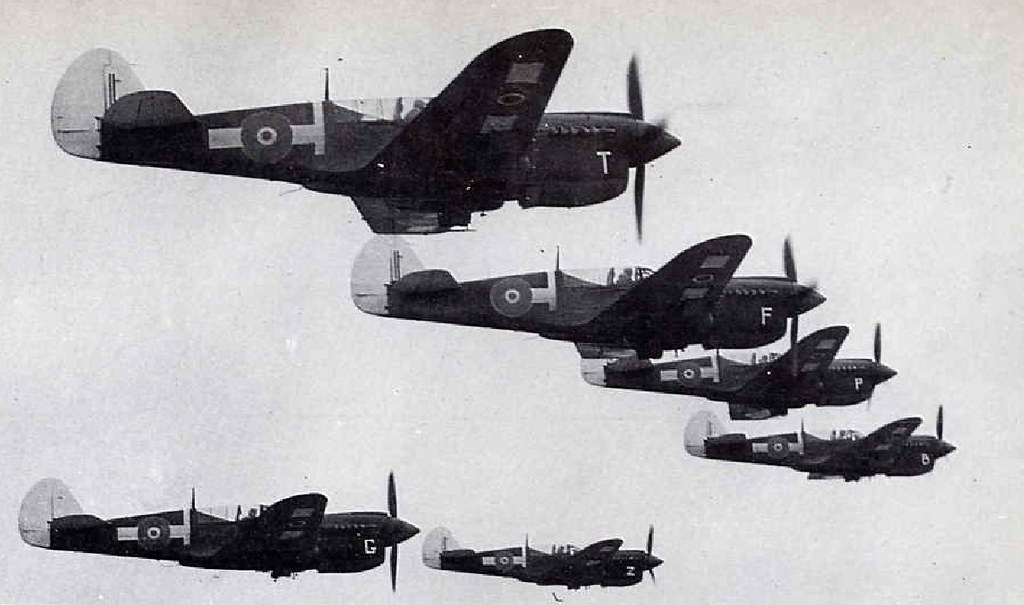
|
|
|
|
Post by Tony on Jun 26, 2011 22:17:47 GMT 12
Yes, a case of poor research by the look of things. Often the case that these myths started way back in the 1960's and 70's when something incorrect was published and has become the "known history" whereas the true facts emerge years later but people still refer to the wrong material as it has been perpetuated so often. Dave Interestingly you should mention that, have been told on at least one occassion by an "Overseas" so called researcher that we of the Antipodies don't know what we are talking about, and that these so called researchers know better than us and we should get used to it 
I was told that Pacific Wings Magazime was not being published then - so I must be confusing it for The Aeroplane! |
|
|
|
Post by Dave Homewood on Jun 26, 2011 23:49:59 GMT 12
The predecessor of New Zealand Wings magazine was simply called "Wings - The National Flying Paper" and the first issue, Volume 1, Number 1, was released by Technical Publications Limited of 22-24 Brandon Street, Wellington in August 1932. The cover featured Sir Charles Kingsford Smith and a DH60 Moth.
Wings became the magazine of the New Zealand Aero Club I believe, but I am told it was also available to the public through shops from the earliest days.
As for the spinners on the P-40N's in that formation, they look olive drab to me, not grey.
As for the other photo and the strange roundel, I am going to persue a line of enquiry on that one and see what I can find out. Thanks for the photos.
|
|
|
|
Post by Dave Homewood on Jun 27, 2011 1:15:37 GMT 12
Kerry Foster emailed these photos to me today to post here. A rare shot of a Gloria Lyons P-40 crashed. 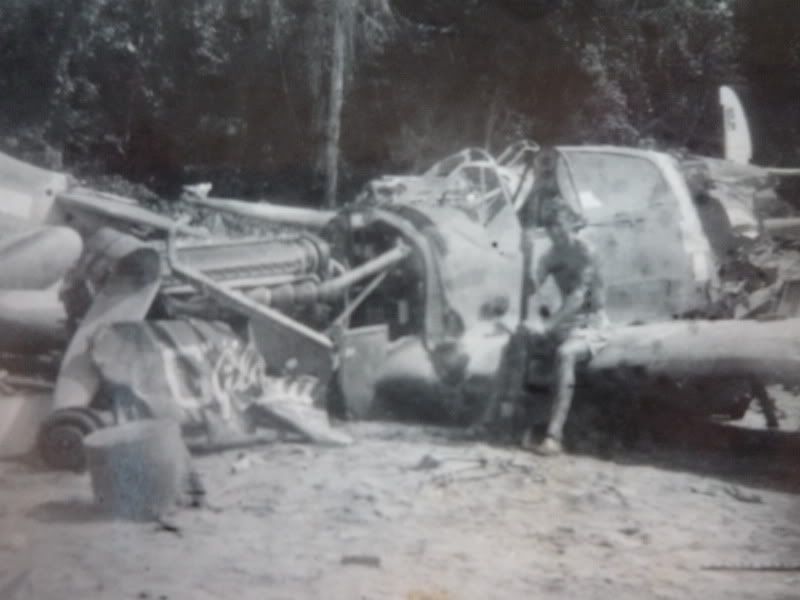 Tutae Wera 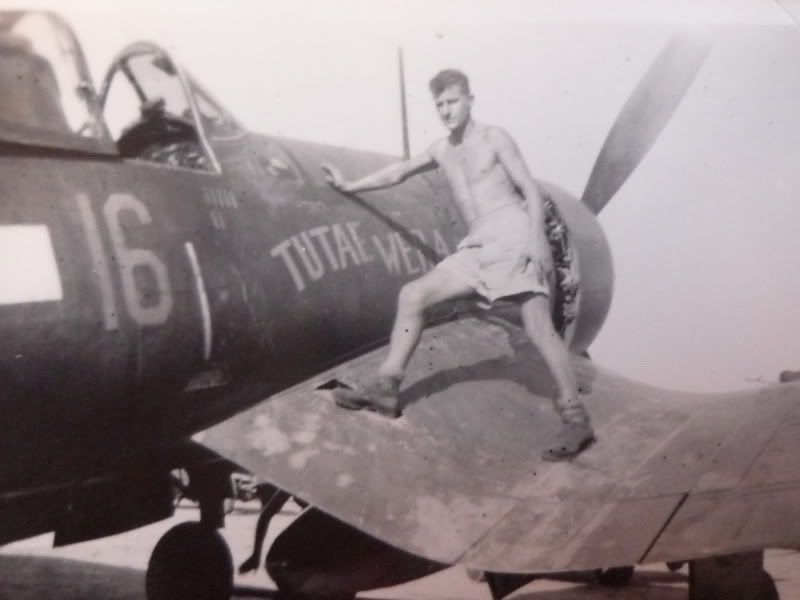 I have two more to add tomorrow. |
|
|
|
Post by baz62 on Jun 27, 2011 10:35:17 GMT 12
There are some great photos there Dave, man that Gloria Lyons Kittyhawk has had a difficult landing, looks like the cockpit is intact so hope he didn't get too badly injured.
|
|
|
|
Post by Tony on Jun 28, 2011 17:31:05 GMT 12
There are some great photos there Dave, man that Gloria Lyons Kittyhawk has had a difficult landing, looks like the cockpit is intact so hope he didn't get too badly injured.
www.adf-serials.com/nz-serials/nz3001.shtml
NZ3148: Damaged in crash landing at Torokina on 09 February 1944. The engine failed just prior to landing and the aircraft missed the runway, hitting a mound of earth and somersaulting. Sergeant Pilot Charles Woods unhurt. |
|
|
|
Post by errolmartyn on Jun 28, 2011 19:58:18 GMT 12
NZ3148 "While buzzing strip engine failed. Pilot gained height, endeavoured to land down wind, the only alternative available to him, but floated down strip and crashed at end of runway."
Aircraft had been engaged on close cover escort.
Correct name of pilot is NZ4213311 Charles Stewart Wood (not Woods). Exactly a fortnight later he was obliged to bale out of NZ31667 6 miles west of Torokina due to AA damage.
Errol
|
|
|
|
Post by Tony on Jun 28, 2011 20:26:11 GMT 12
Thanks Errol, I just looked at my own data and I had him listed as Wood (s)
|
|
|
|
Post by Dave Homewood on Jun 28, 2011 22:38:38 GMT 12
Here are the other two photos that Kerry Foster sent for this thread. Sorry about the delay. they show Taurangaruru. 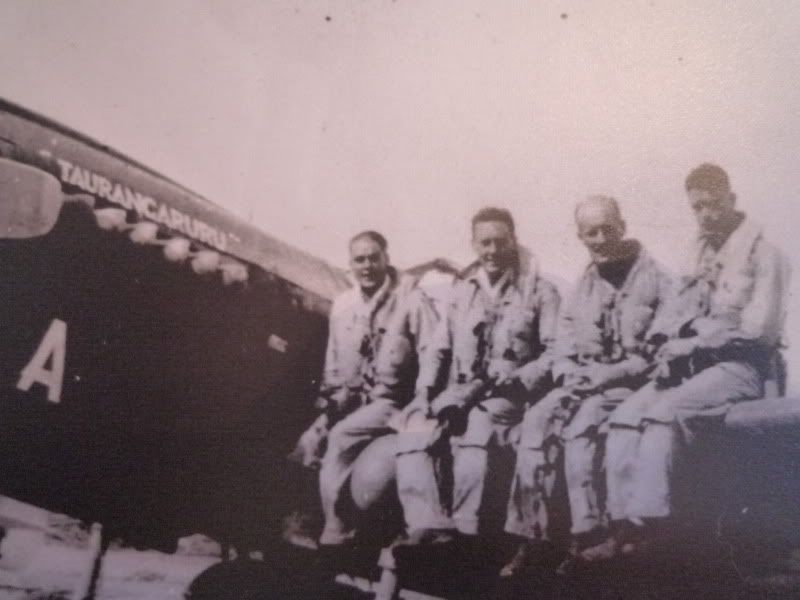 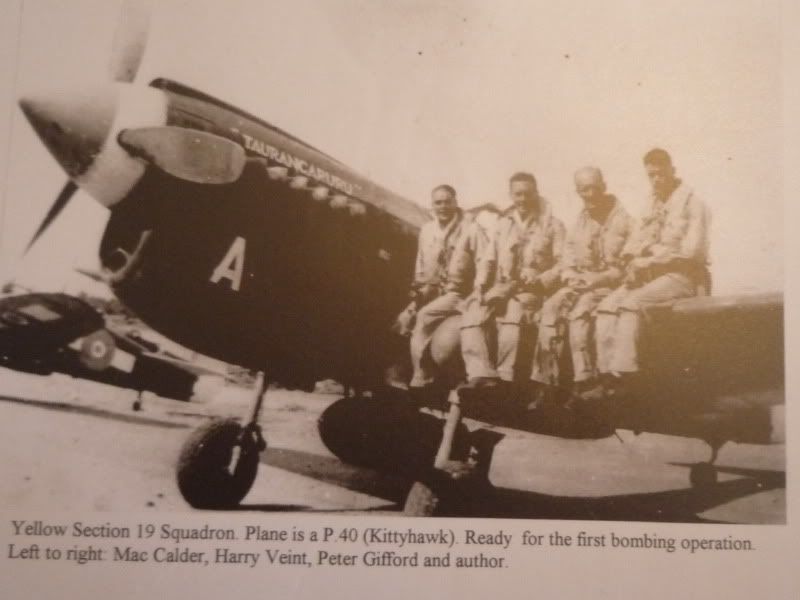 |
|
|
|
Post by Dave Homewood on Jun 29, 2011 13:56:55 GMT 12
The two-tone spinner on "Taurangaruru" is interesting, eh.
|
|
|
|
Post by Dave Homewood on Jun 29, 2011 15:16:39 GMT 12
Here are the photos from the issues of New Zealand Wings dealing with the No. 19 Squadron P-40N names: From December-January 1994: 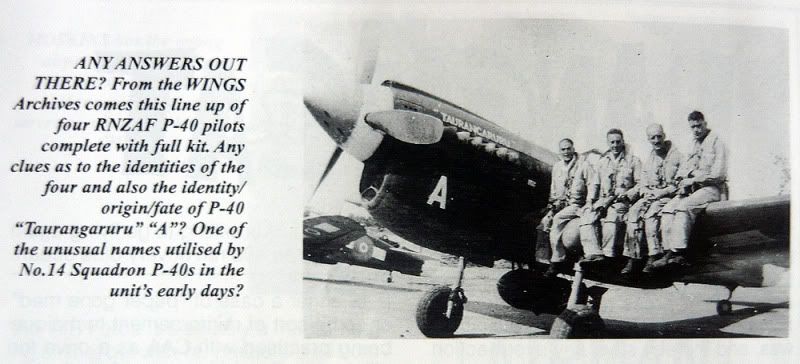 From February 1994: 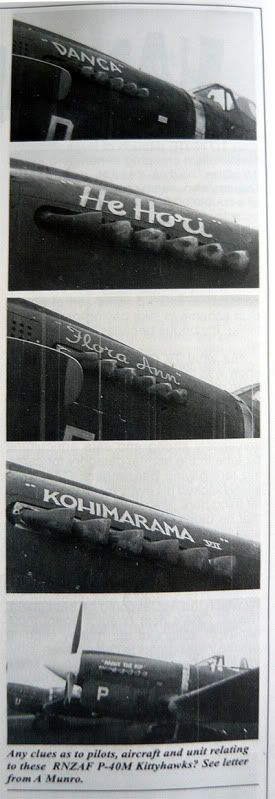 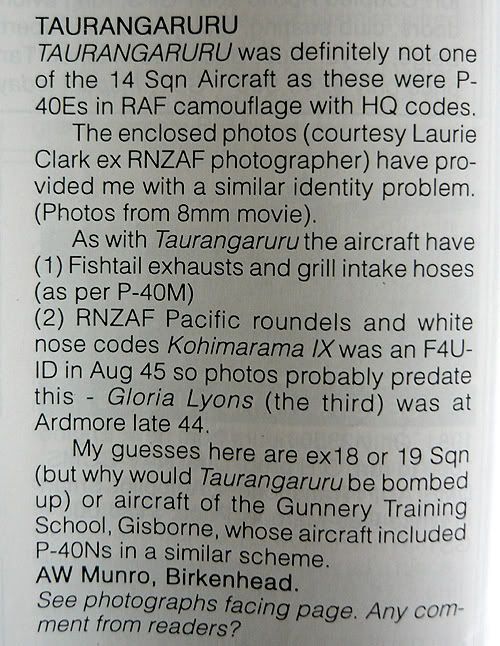 Does/did anyone know ex-RNZAF photographer Laurie Clark? What became of the 8mm film that these photos came from? Does/did anyone know ex-RNZAF photographer Laurie Clark? What became of the 8mm film that these photos came from?From May 1994: 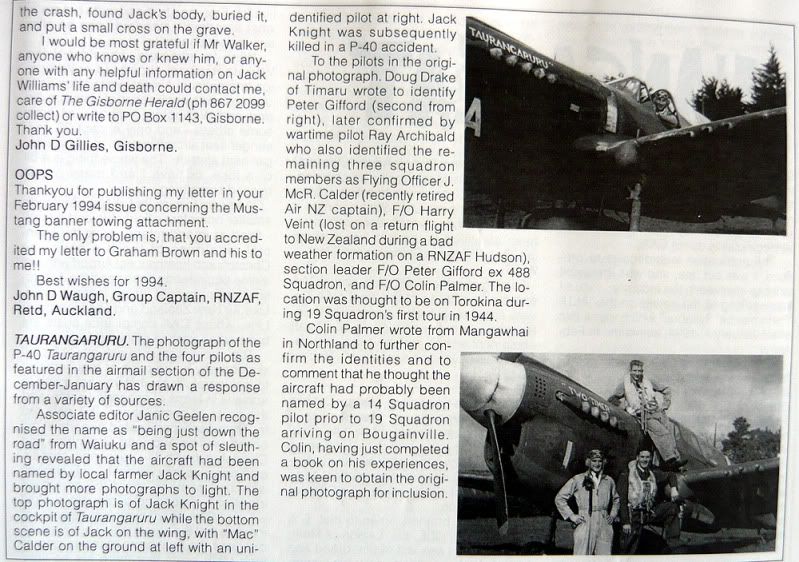 I reckon that Colin might be mistaken that No. 14 Squadron applied the names because Skip Watson definately had his applied by his "ESMA LEE" groundcrew, and he was No. 19 Squadron. Maybe it was a mix from both squadron's usage of the aircraft with the Servicing Unit. Note that all these P-40's seem to ahve the little white rectangle on the bottom-rear end of the cowl like "ESMA LEE" did. Any ideas why? |
|
|
|
Post by Dave Homewood on Jul 1, 2011 1:58:10 GMT 12
 Back to this fairly bogus sheet of colour profiles posted earlier. The photo that was also posted looked familiar to me and I confirmed thta the was cropped from a larger scene in Brendon Deere's book Military Wings. That publication too was hard to see detail in so I emailed Brendon and he kindly looked out the original print and has scanned it for us. Thanks Brendon!! Here's a smaller version than the scan he sent me so it fits here on the page. 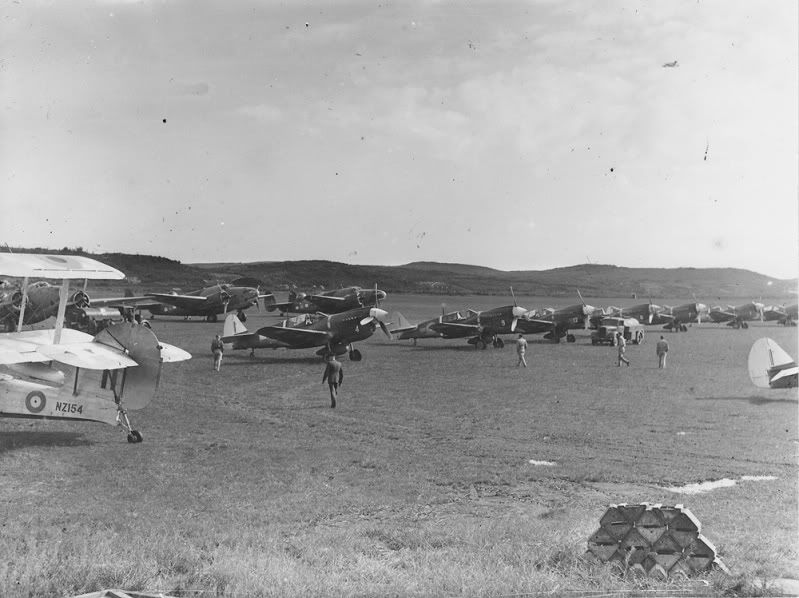 Brendan noted in his email, "I have a note on the back which says “almost certainly 19 Sqdrn P40Ns at Waipapakauri 28th April 1944 after arriving from Guadacanal (left 24th April)”. So noting it was a ferry flight I realised that the job of escort would have fallen to No. 1 (BR) Squadron. I confirmed this with the Squadron ORB for that day which shows four Hudsons leaving Whenuapai on the 21st of April 1944 to head north and meet P-40's for the escort. Here is the page of the ORB showing their return to NZ escorting the P-40's. 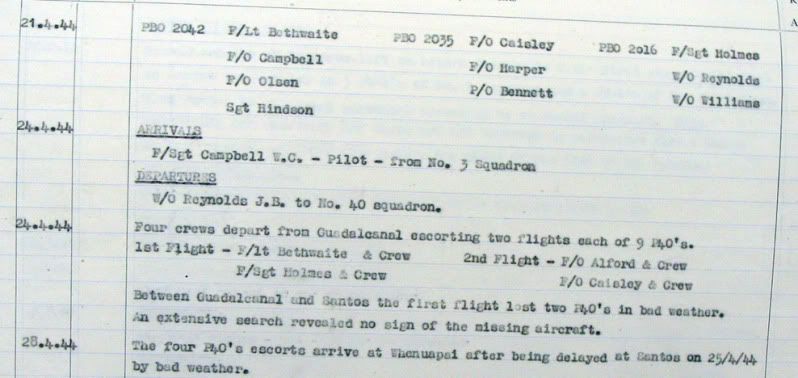 I needed to confirm wither the Warhawks were flown by No. 19 (F) Squadron so I cross referenced this with Allan 'Skip' Watson's logbook which I photographed recently as he was in the squadron and on that tour. It matches, it was definately No. 1 (BR) Squadron Hudsons and No. 19 (F) Squadron Warhawk pilots making the ferry transit through Waipapakauri on this day. This transit from Guadalcanal to NZ proved tragic for No. 19 Squadron. They lost two pilots, F/O Harry Veint and Sgt Keith Armstrong who were lost in weather between Guadalacanal and Santos. The ferry flight was held up there whilst searching but to no avail. I note the presence of an RNZAF Walrus at Waipapakauri in the photo and wonder if it was there for Air Sea Rescue duties in case of further losses. Now, whilst in the circuit at Waipapakauri the engine on Skip Watson's P-40K (NZ3052) burst into flames. He managed to get the aircraft down safely but it gave him a hell of a fright. 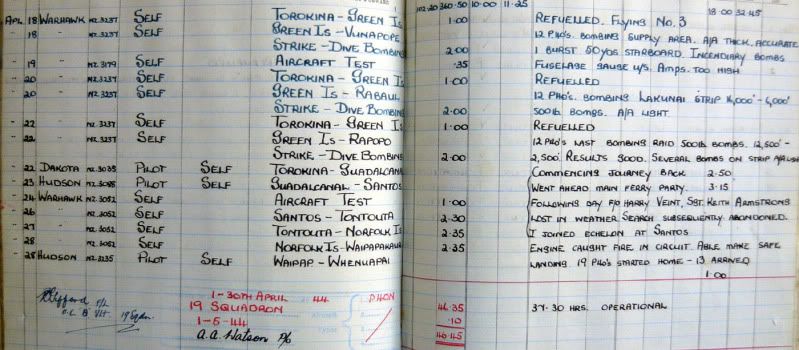 I am now conceiving a theory that perhaps NZ3052 was the aircraft coded '9' with the darkened roundel bar. You'll note that the white tail is also quite a lot darker then the P-40 next to it on the left of the photo yet it's sitting in the same amount of daylight and is not appearing to be sitting in shadow. Perhaps the darkening on the white paint is soot or scorching or oil particles from the engine fire? It's just a theory, but I'll put it to the masses here on the forum and see what people think. You'll note that the underwing roundel bars are fairly bright white compared with the side bar. Here's a closer look. 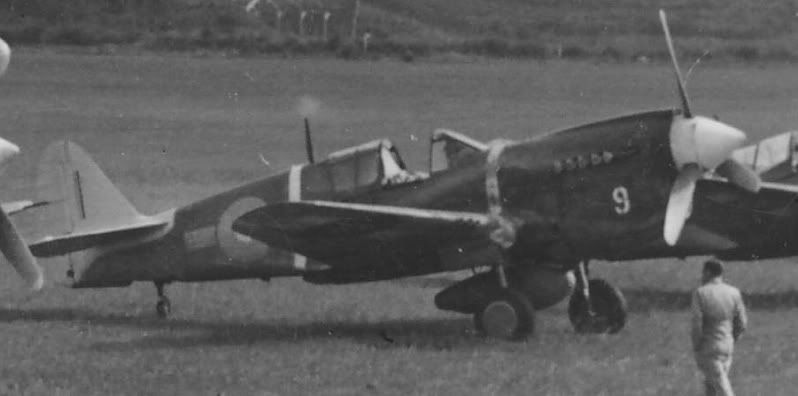 Incidentally NZ3052 was the aircraft that Ken Morpeth had to land on the beach near Noumea on the aborted first tranist of fighters from NZ to the Solomons a year before, with No. 40 Squadron when three aircraft ended up on the beach and two in the sea. Funny how it had a mishap on its transit home too. So, I put to you this: - What nose code did NZ3052 carry at this time in April 1944? - Could NZ3052 be '9' that is seen with the darkened white markings? - If yes, was this the result of the fire? - Was there ever actually a blue roundel bar? I suspect no. - Can people more expert than I confirm that '9' in the photo is a P-40K? Over to the panel... |
|
|
|
Post by Dave Homewood on Jul 1, 2011 2:18:18 GMT 12
Further to the above I want to add some more scans. This one is a larger version of the aircraft next to '9' which shows well the contrast in colours/shades between the white of the tails two aircraft, with '9's tail in the right of the photo. 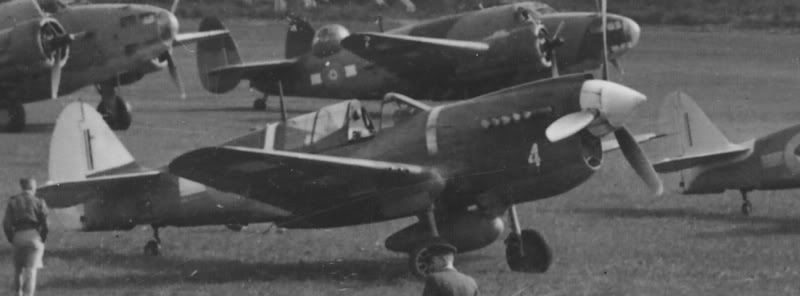 Also I realised that the logbook page might be a bit tiny for people to read so here are larger versions of the key bits. You'll not the top half of the page was ops all flown in Skip's beloved NZ3237 "ESMA LEE", his personal P-40N. But they then went by Dakota at the end of their tour and picked up a batch of different aircraft to ferry home. So these are not the aircraft that we've been discussing earlier that No. 19 Squadron flew on ops with all the neat names. 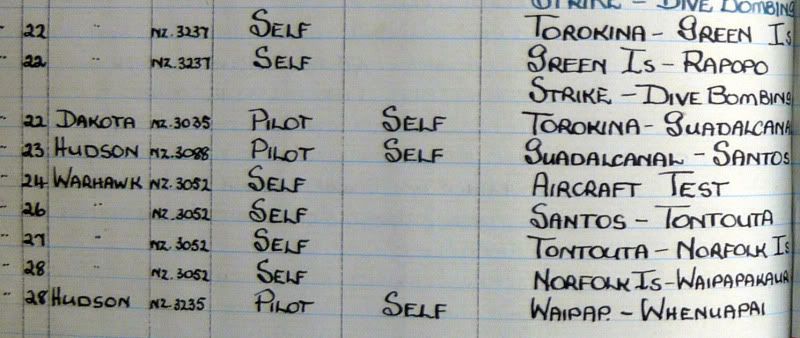 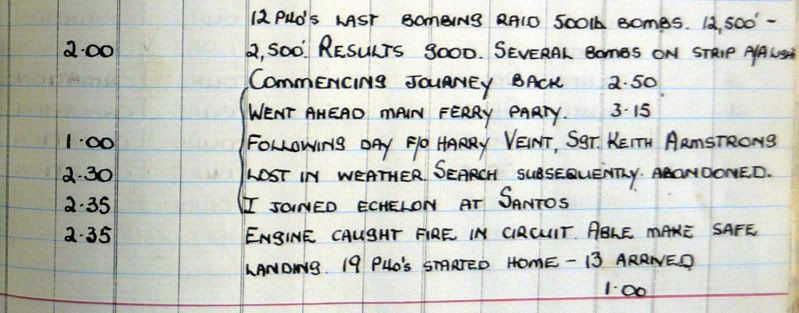 The comment in Skip's logbook that 19 P-40's set out and ony 13 arrived is rather sad. Especially considering he'd lost two mates and had a major issie himself. It sounds like these aircraft must have been well and trully coosed. |
|
|
|
Post by Tony on Jul 1, 2011 9:23:50 GMT 12

A couple of other points:
Not the difference in the height of the insignia bars on the fuselage.
The white bar on 4 is a lot higher than the blue one on 9
The difference in the white of the tail feathers, some wrap around the tailplane while others are just on the fin.
Is this a K v M thing?
|
|
|
|
Post by Dave Homewood on Jul 1, 2011 13:48:23 GMT 12
I wonder if the 'bar' on '9' is even a bar, maybe it's a repair patch?
My theory of smoke/scorching may not hold water when you look at the vertical bands on '9' as they are much whiter and you'd think the one beside the roundel would be grey too if there was smoke damage.
I had noted the different white tail style but I assume these aircraft are a mix from servicing units being ferried home. This was just as the P-40's were being phased out of the front lines and replaced with Corsairs and I don't think it would be a surprise to see different styles on the aircraft as they may be from different times of entry to service.
I love the white bars on the Hudsons, that's something not often seen and certainly not back when they were frontline reconnaissance bombers.
|
|
|
|
Post by Dave Homewood on Jul 2, 2011 1:14:44 GMT 12
I have just discovered this awesome photo in a collection we scanned last week. Gloria and Erica:  |
|
|
|
Post by Dave Homewood on Jul 2, 2011 1:35:28 GMT 12
WOW!! And this one too. It rips my kilt because the portable scanner only does up to 600dpi and that is inadequate to read the names on all these P-40's, but it is obvious that almost every aircraft in this photo has a name. We have: P- PADDY THE RIP G - GLORIA LYONS E - Erica J - ? T = ? V = ? B = ? S = ? N = ? = ? (not sure what the code is either) All those code lettered aircraft have names on the cowls. I might have to see if I can borrow the photo, and get the owner to post me it, so I can scan it with a decent scanner. What a find, I have never seen so many named aircraft in one place before. That is at least 10 in that shot. 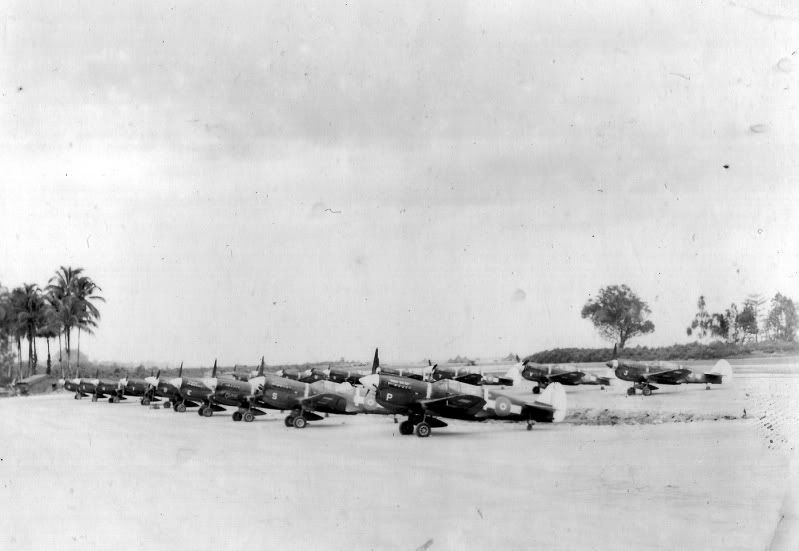 |
|
|
|
Post by Tony on Jul 2, 2011 11:14:34 GMT 12
Brilliant photos Dave.
Just a thought about 'blue-bared' 9
Both 4 and 12 either side are later N models.
So I am wondering if 9 is a N-1
|
|
|
|
Post by Dave Homewood on Jul 2, 2011 13:25:20 GMT 12
Did the N-1 not have the glasshouse back canopy?
|
|



